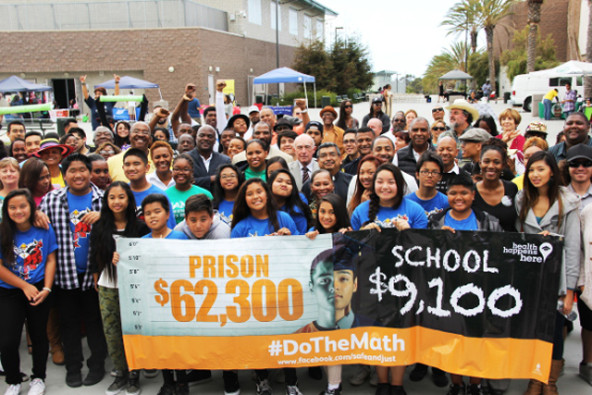Health happens in communities.
Many people living in low-income communities in the United States are mired in a constant and unremitting fog of stress. This chronic stress is driven by housing insecurity, food insecurity, fear of crime, unemployment, exposure to pollution, and poor education. These things lead to poor community health and are often collectively conceptualized as social determinants of health.

The good news is that this situation is largely manmade and thus can be unmade. Our initiative, Building Healthy Communities (BHC), is a holistic attempt to help reweave the fraying fabric of low-income communities by harnessing the latent power and potential of their residents. Launched in 2010, it is a 10-year, $1 billion, place-based initiative that aims to transform 14 communities by building power (social, political, and economic), implementing proven health-protective policy, and changing the narrative about what produces health (beyond health insurance and individual behavior). BHC’s strategy is grounded in the belief that health is fundamentally political. The idea is to revitalize local democracy to transform these environments into places where everyone has the opportunity to thrive.
The BHC model envisions these communities as proving grounds for community-driven policy and practice innovations that, in turn, advance statewide policy and systems change. It creates unprecedented space for community organizing, leadership development, and sustained multi-sector collaboration by enabling residents, community groups, and institutional leaders to work together across all sorts of boundaries, including different races and ethnicities, personal experiences, legacies of discriminatory treatment, and differential levels of power.
While the approach is the same across all sites – build power, change narrative and policy/systems – it manifests differently depending on local circumstances. In Fresno, California, for instance, the work is taking the form of unlikely alliances between community and environmental groups interested in ensuring that the city grows sustainably for both people and the environment. In East Salinas, California, the community is coming together with public servants to heal and put racial equity at the forefront of all city policies, practices, and procedures.
 At a community festival in San Diego school children illustrate the benefit of investing in schools rather than prisons; our San Diego Organizing Project sponsored the festival. (Photo by JoAnn Fields)
At a community festival in San Diego school children illustrate the benefit of investing in schools rather than prisons; our San Diego Organizing Project sponsored the festival. (Photo by JoAnn Fields)
The problems facing each of these communities are old and deep. There are numerous strategic challenges in deciding how to use the money that BHC provides—challenges that surface regardless of investment size and fit into the following six broad categories:
1. Seeking alignment. A community is not a vacuum. When a foundation like ours enters into a community, there is a lot of other work happening already. There are prominent leaders and other natural leaders who have been creating change at various levels in the community. How foundations identify and align their efforts with pre-existing work is critical to building trust and acceptance.
2. Synchronizing with residents. Fostering collaboration between residents, community-based organizations, and system leaders means overcoming profound cultural differences, linguistic barriers, acronyms and other insider jargon, and enormous power imbalances. Each of these constituencies has different learning curves. Foundations may need to sequence and synchronize their work in a way that gives residents the time and opportunity to train and prepare so that they can come to the collaborative table ready to engage in meaningful dialogue and not feel intimidated. At the same time, system leaders may feel ambushed if foundations don’t properly introduce them to the initiative’s approach.
3. Setting goals. Foundations come to the work with a point of view. Communities, by definition, have multiple points of view. All must negotiate these competing perspectives to develop trust. Thus foundations should neither hold too tight to a set of goals, nor be opaque about what it wants to accomplish. Short-term, medium-term, and long-term goals must be explicit but open to negotiation and renegotiation—no rigid agendas and no hidden agendas. Ownership of multi-year initiatives should transition to the community and its leadership over time, and understanding and supporting this maturation process is essential.
4. Making it sustainable. It is unusual for foundation-funded, community-driven initiatives to achieve their goals quickly or even within a timeframe defined by their board. Initiatives usually need to establish proxy goals that are harbingers of longer-term goals. With the achievement of proxy goals and the development of community leadership and collaborative capacity, foundations and community partners must create and implement sustainability strategies—a major challenge for foundation-funded initiatives.
In low-income communities, often the only available source of sustainable funding is government, and enlisting government support for community initiatives requires significant political buy-in. The process for developing that buy-in has to begin very early. A significant challenge in this is that government is often reticent to support—through participation or funding—initiatives that focus on shifting policies through building power. There are many reasons for this, not least of which is the necessary tension between government and the community groups that want to hold it to account.
Achieving government buy-in for an initiative might require shifting investment away from community organizing. This is potentially a very high cost and could risk the longer-term success of the initiative. For the time-being, we are continuing to experiment with sustainability strategy designs that defend and maintain the initiative’s goal to build resident voice and power.
5. Avoiding fatigue. Foundations are notorious for being dilettantish and unaccountable, and boards get bored. At the same time, it is essential that foundation boards understand the need for an appropriate initiative length and commitment. A proactive strategy to ensure that boards are deep engaged is essential. With BHC, we matched board members to sites, asking them to visit the sites and regularly connect with program managers at those sites. This deepens their commitment and their understanding of the overall strategy.
6. Evaluating our efforts. Given that BHC sees these 14 communities as proving grounds, evaluating our efforts is a critical component of everything we do. Our organization is grounded in the spirit of ongoing and continuous learning, and so developing the BHC evaluation questions and methodology has been iterative. Each site has a learning and evaluation team that serves as the bridge between the community partners, and the foundation’s learning and evaluation staff. Together, they’ve designed surveys that measure collaboration strength, the efficacy of policy advocacy, and much more. The point is not so much to uncover weaknesses; it’s to find what is working, and share learning within and across the sites so that everyone benefits.
Building Health Communities has taught us many things, perhaps none as significant as the importance of power in our democracy - the stronger our local democracies, the healthier our communities. We believe that the biggest challenge to the health of communities is encouraging continuous investment in the great venture that is American democracy. The biggest threat to democracy is the tendency of power to concentrate in the hands of the few. Community organizing is the strongest antidote to this, but it’s also controversial and usually underfunded. In as much as government works at the behest of the public, it must work to foster a civically engaged, well-informed populace. The government sector must embrace the vital role that community organizing plays in creating a functioning democracy and invest in organizations and opportunities that build power in the most under-represented communities. This will bring it closer to the ideal of a government of the people, for the people, and by the people—all the people.
Support SSIR’s coverage of cross-sector solutions to global challenges.
Help us further the reach of innovative ideas. Donate today.
Read more stories by Anthony B. Iton.

